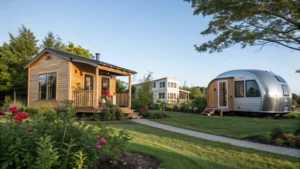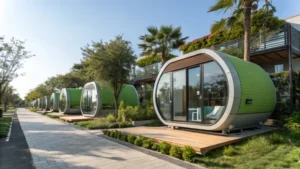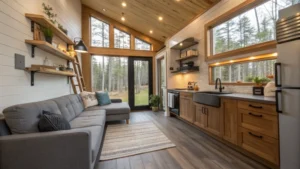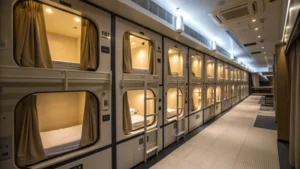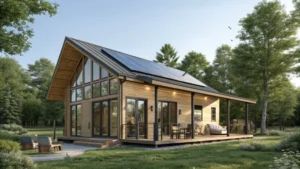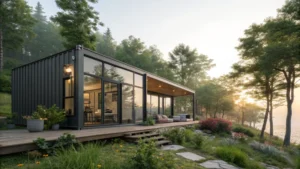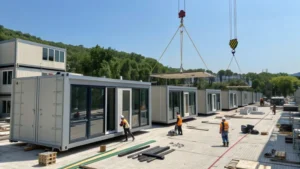%[A modern tiny house in a green forest surrounded by wildflowers](https://cozehouse.com/wp-content/uploads/2024/12/modern-tiny-house-in-forest.webp "Tiny House in Forest")
Have you ever wondered how living small can make such a big impact on the planet?
**Tiny houses benefit the environment by using fewer resources, consuming less energy, and producing minimal waste. Their compact design promotes efficient land use, while eco-friendly materials and renewable energy systems boost their sustainability.**
I remember the first time I stepped into a tiny house, feeling both skeptical and curious. It was like walking into a cozy haven where every inch was thoughtfully designed. The sheer brilliance of using less to do more hit me like a light bulb moment. These small homes are not just cute and trendy; they’re environmentally revolutionary! By embracing smaller spaces, we reduce our ecological footprint significantly. Tiny houses naturally consume fewer resources for construction and maintenance, which means less waste and a positive impact on our planet.
Plus, they’re incredibly energy-efficient. Imagine your heating bill shrinking along with your square footage! With better insulation and clever designs, tiny homes use much less energy for heating and cooling. Many even incorporate renewable energy systems like solar panels, making them nearly self-sufficient. Living in a tiny house encourages a minimalist lifestyle too—less clutter and fewer possessions mean we’re not only saving space but also cutting down on waste.
Tiny houses are more than just a trend; they’re a movement towards sustainable living. For those of us wanting to tread lightly on the earth, they offer an inspiring path forward.
Tiny houses reduce energy consumption significantly.True
Tiny houses have smaller spaces to heat and cool, lowering energy use.
All tiny houses are built using eco-friendly materials.False
Not all tiny houses use eco-friendly materials; it varies by builder.
## What Makes Tiny Houses More Energy Efficient?
I remember the first time I stepped inside a tiny house—its energy efficiency took me by surprise. So, what exactly makes these small wonders so eco-friendly?
**Tiny houses are energy efficient because their smaller space reduces the need for heating and cooling. They often boast airtight designs, superior insulation, and utilize renewable energy sources, making them sustainable and cost-effective.**
%[A modern tiny house surrounded by greenery](https://cozehouse.com/wp-content/uploads/2024/12/modern-tiny-house-serene-environment.webp "Modern Tiny House")
### Reduced Space, Reduced Energy Demand
I once visited a friend who lived in a tiny house during a particularly chilly winter. I noticed how quickly her home warmed up compared to my larger house. With less space to manage, tiny homes naturally require less energy for heating and cooling. This is especially beneficial in [climates with extreme temperatures](https://nestron.house/blogs/all-you-need-to-know-about-heating-and-cooling-systems-in-tiny-homes)[^wmthmee-1], where the energy savings become even more pronounced.
### Airtight Designs and Superior Insulation
The first time I installed high-quality insulation in my own home, it was like wrapping it in a warm, cozy blanket. Many tiny houses take this a step further with airtight designs and top-notch insulation, significantly reducing the need for extra heating or cooling. By preventing drafts and maintaining a consistent indoor climate, these homes are champions of energy conservation. Materials like spray foam insulation are often used to enhance thermal performance.
### Integration of Renewable Energy Sources
Imagine powering your entire home with just a few solar panels or a small wind turbine! That's a reality for many tiny house owners. Their minimal energy needs make it feasible to integrate renewable technologies, allowing some to live entirely off-grid. This is a fantastic advantage for [sustainability-focused individuals](https://www.solarreviews.com/blog/solar-panels-for-tiny-houses)[^wmthmee-2] who want to minimize their carbon footprint.
### Eco-Friendly Materials and Construction Techniques
When I built my own small garden shed using reclaimed wood, I was amazed at how much character and warmth it added. Tiny houses often incorporate sustainable materials like reclaimed wood and recycled steel. Not only do these choices reduce environmental impact, but they also contribute to the home's energy efficiency by providing superior thermal properties. Builders often favor [minimalist designs](https://unitedtinyhomes.com/find-your-dream-tiny-home-benefits-of-minimalism-and-design-tips-for-small-spaces/)[^wmthmee-3] that maximize natural light and airflow, cutting down on the need for artificial lighting and ventilation systems.
### Efficient Water Systems and Appliances
I once stayed in a tiny house equipped with water-saving fixtures and was impressed by how seamlessly they worked. Many tiny homes have water conservation systems like low-flow fixtures and rainwater harvesting setups, which work alongside energy-efficient appliances to minimize water and electricity use. By reducing water heating needs, these features enhance overall energy efficiency. Compact refrigerators and induction cooktops are popular choices for [small living spaces](https://www.bestbuy.com/site/home-appliances/small-home-appliances/pcmcat1516993407875.c?id=pcmcat1516993407875)[^wmthmee-4], designed specifically to fit the tiny house lifestyle.
#### Example Table: Energy Efficiency Features of Tiny Houses
| Feature | Benefit |
|---------------------------------|-------------------------------------------------------|
| Reduced Space | Lowers heating/cooling needs |
| Airtight Design | Minimizes air leaks |
| Superior Insulation | Maintains indoor climate efficiently |
| Renewable Energy Integration | Reduces reliance on non-renewable sources |
| Eco-Friendly Materials | Offers better thermal properties |
| Efficient Water Systems | Lowers water heating demands |
Understanding these features helps prospective tiny house owners appreciate the strategic design and technology choices that make these homes stand out in terms of energy efficiency.
Tiny houses require less energy for heating and cooling.True
Their reduced space significantly decreases overall energy demand.
Tiny houses cannot be powered entirely off-grid.False
They often use solar panels and wind turbines to meet energy needs.
[^wmthmee-1]: Exploring this link reveals effective methods tiny houses use to maintain comfort in varying climates.
[^wmthmee-2]: Learn how integrating renewable sources makes tiny houses more sustainable and self-sufficient.
[^wmthmee-3]: Discover how minimalist design enhances energy efficiency in tiny house living.
[^wmthmee-4]: Find out which appliances maximize efficiency in tiny homes, saving energy and space.
## Why Are Tiny Houses a Great Option for Sustainable Living?
Ever thought about living in a home so cozy that it practically hugs you back while saving the planet?
**Tiny houses champion sustainable living by slashing resource use, boosting energy efficiency, and fostering minimalist lifestyles. They utilize eco-friendly materials and off-grid systems, cutting waste and shrinking carbon footprints.**
%[A modern tiny house surrounded by lush greenery](https://cozehouse.com/wp-content/uploads/2024/12/modern-tiny-house-green-environment.webp "Modern Tiny House")
### Smaller Environmental Footprint
I remember standing in front of my newly-built tiny house, marveling at how a small space could feel so full of possibilities. The construction required far fewer materials than a traditional home, significantly reducing waste. It's like watching the process of making a gourmet meal out of just a few simple ingredients. This minimalistic approach is perfect for urban areas where every square foot counts. Imagine vibrant eco-friendly communities flourishing amidst bustling cityscapes! Tiny houses drastically cut down the [resource consumption](https://learn.aiacontracts.com/articles/how-tiny-homes-are-helping-save-the-environment/)[^wathagofsl-1] required for construction.
### Energy Efficiency
One chilly winter morning, I realized how effortlessly my tiny home maintained warmth. Its compact design naturally uses less energy for heating and cooling, with airtight structures and top-notch insulation making the most of what little energy is needed. Adding solar panels felt like plugging into the sun itself—my home was truly an [energy-efficient](https://www.ecobee.com/en-us/citizen/are-tiny-homes-a-sustainable-solution/)[^wathagofsl-2] marvel! If you've ever considered living off-grid, tiny houses make it surprisingly attainable.
### Sustainable Building Materials
Building my tiny house was an adventure in sourcing sustainable materials. Using reclaimed wood and recycled steel gave it a unique character while supporting the recycling industry. The process reminded me of treasure hunting, each piece carrying its own story. Opting for these [sustainable building materials](https://unitedtinyhomes.com/eco-friendly-tiny-house-materials/)[^wathagofsl-3] isn't just about reducing new resource demand; it's about breathing new life into the old.
### Waste Reduction and Water Conservation
With efficient water systems like rainwater harvesting, my tiny house has taught me to cherish every drop. It's fascinating how limited space naturally encourages a minimalist lifestyle, leading to less waste generation. Composting toilets were a quirky adjustment at first but have become part of this rewarding journey toward sustainability with [efficient water systems](https://unitedtinyhomes.com/how-do-tiny-houses-get-water-essential-guide-to-supply-systems/)[^wathagofsl-4].
### Reduced Transportation Impact
The mobility of tiny houses is another hidden gem I discovered. Built on trailers, they move with ease, reducing the environmental toll of housing development. The minimal site preparation required means less soil disruption and fewer emissions from construction machinery—a win for both nature and wanderlust-filled hearts.
| Benefit | Description |
|-----------------------|--------------------------------------------------------------------------|
| Environmental Footprint | Reduces resource use and waste generation |
| Energy Efficiency | Uses less energy for heating/cooling; integrates renewable sources |
| Building Materials | Employs eco-friendly and recycled materials |
| Water Conservation | Features efficient systems like rainwater harvesting |
| Transportation Impact | Requires minimal site prep; offers mobility for eco-friendly relocations |
Tiny houses use less energy than traditional homes.True
Due to their smaller size and efficient design, tiny houses require less energy.
Tiny houses cannot incorporate renewable energy sources.False
Many tiny houses easily integrate solar panels or wind turbines for power.
[^wathagofsl-1]: Learn how tiny houses use fewer materials compared to traditional homes, minimizing waste and environmental impact.
[^wathagofsl-2]: Discover the design features that make tiny houses highly efficient in energy consumption.
[^wathagofsl-3]: Explore the eco-friendly materials commonly used in building tiny homes.
[^wathagofsl-4]: Understand the water-saving technologies integrated into tiny house designs.
## Can Tiny Houses Be a Solution for Urban Overcrowding?
Ever feel like the walls are closing in on you in the city? I’ve been there, too. Could tiny houses be the answer to our urban woes?
**Tiny houses can help tackle urban overcrowding by optimizing space use, minimizing environmental impact, and offering budget-friendly housing. Their compact footprint allows for higher density living and innovative urban planning.**
%[A row of colorful tiny houses with greenery and a city skyline](https://cozehouse.com/wp-content/uploads/2024/12/colorful-tiny-houses-urban-setting.webp "Colorful Tiny Houses in Urban Setting")
### Maximizing Space Efficiency
I remember when I first stumbled upon a tiny house village tucked away in a bustling city neighborhood. It was like discovering a secret garden amidst the concrete jungle. These tiny homes were designed to squeeze every ounce of utility from their limited space, something that’s crucial when you're dealing with scarce land in urban areas. Their smart, compact designs mean that we can fit more homes into smaller spaces, making them ideal for boosting housing density without losing that cozy comfort we all crave.
| Feature | Benefit |
|-----------------|---------------------------------------------|
| Compact Design | Fits multiple homes in limited urban spaces |
| Modular Layout | Allows for customization and flexibility |
### Reducing Environmental Impact
I’ve always been passionate about living sustainably, and tiny houses hit the sweet spot for environmental stewardship. Imagine using less energy to heat and cool your home, or utilizing reclaimed materials that give your house a unique character while saving the planet. By integrating [renewable energy systems](https://www.sulexinternational.com/power-tiny-home-with-renewable-energy/)[^cthbasfuo-1] like solar panels, these homes shrink their carbon footprint even further.
- **Materials:** Use of reclaimed or sustainable materials like bamboo.
- **Energy:** Lower energy requirements for heating and cooling.
- **Water:** Efficient water systems reduce consumption and waste.
### Providing Affordable Housing Options
With real estate prices skyrocketing, owning a home can feel like an unattainable dream. But tiny houses offer a glimmer of hope. They’re not just smaller in size but also in cost, providing a more affordable entry point into homeownership. I’ve seen how this can transform lives, offering a stable base from which people can build their futures without being shackled by debt.
- **Initial Costs:** Generally lower than traditional homes.
- **Maintenance:** Reduced costs due to smaller space.
- **Mobility:** Potential for relocation without significant expense.
### Innovative Urban Planning Opportunities
I’ve talked to urban planners who are excited about the possibilities tiny houses present. They’re not just about solving housing shortages; they’re about reimagining how we live together in cities. By integrating [tiny homes](https://www.tenantcloud.com/blog/tiny-house-costs-the-pros-and-cons-of-living-minimally)[^cthbasfuo-2] into existing neighborhoods or crafting new mini-villages, we can foster community interactions and create vibrant, inclusive living spaces.
- **Community Living:** Shared amenities encourage social interaction.
- **Zoning Flexibility:** Potential to redefine residential zoning laws.
- **Mixed-Use Areas:** Incorporation into existing urban landscapes.
Tiny houses might not be the silver bullet for all urban challenges, but they certainly offer intriguing possibilities for reshaping our cities into more sustainable and community-focused environments.
Tiny houses reduce urban overcrowding.True
Their compact design allows higher density living in limited spaces.
Tiny houses increase environmental impact.False
They use fewer materials and integrate renewable energy systems.
[^cthbasfuo-1]: Learn about integrating renewable energy systems to reduce the carbon footprint of tiny homes.
[^cthbasfuo-2]: Discover why building tiny homes is a cost-effective solution for urban housing.
## What Challenges Do Tiny Houses Face in Broader Adoption?
Embracing the tiny house lifestyle is a dream for many, but several challenges can make it feel more like a high-wire act than a cozy retreat. Ever wondered what those hurdles are?
**Tiny houses face barriers like restrictive zoning laws, tricky financing, and societal biases that hinder their widespread adoption. Overcoming these challenges is crucial for making tiny homes a mainstream housing solution.**
%[A modern tiny house surrounded by traditional homes in a suburban neighborhood](https://cozehouse.com/wp-content/uploads/2024/12/tiny-house-modern-suburban.webp "Modern Tiny House in Suburbia")
### Zoning and Regulatory Barriers
Imagine finding the perfect plot of land for your dream tiny house, only to discover it's not legally permissible to place it there. That's the reality many aspiring tiny home dwellers face due to stringent zoning laws. Some places are catching on and starting to create tiny house-friendly communities or offer variances, but it's a slow march towards acceptance. I remember chatting with a friend who spent months battling local regulations just to secure a spot for their tiny home. For those interested in understanding the intricate web of zoning laws, the [zoning laws impact](https://www.businessinsider.com/tiny-house-owners-zoning-laws-2020-12)[^wcdthfiba-1] article is a must-read.
### Financing and Mortgage Challenges
When I first considered the tiny house lifestyle, financing was a maze I wasn't quite prepared for. Traditional banks often see tiny houses as risky investments, which means standard mortgages are usually off the table. Instead, people turn to personal loans or niche lenders who specialize in these cozy abodes. It’s like trying to buy a car when everyone else is buying houses—your options are limited and sometimes more expensive. If you're scratching your head over how to finance your tiny home dream, dive into [tiny house financing](https://www.earnest.com/blog/so-you-want-to-buy-a-tiny-house)[^wcdthfiba-2] solutions.
### Perceptions and Lifestyle Fit
The idea of shrinking your living space can be daunting. I recall visiting a family who had fully embraced tiny living, and their enthusiasm was infectious. Yet, societal views can be harsh, painting tiny homes as temporary or unfit for anyone outside certain demographics. However, personal success stories are powerful in changing minds and challenging stereotypes. If you're curious about how people make it work in real life, check out [tiny living experiences](https://tinyhouseexpedition.com/my-tiny-house-journey-what-my-friends-family-think/)[^wcdthfiba-3].
### Space Limitations and Lifestyle Adjustments
Adjusting to a smaller space means rethinking possessions and embracing minimalism—a shift that isn't for everyone. A friend of mine described it as a "life detox," where each item must earn its keep. Yet, those who take the plunge often find freedom in simplicity. If you're considering this transition, [living minimally](https://unitedtinyhomes.com/the-psychology-of-tiny-living/)[^wcdthfiba-4] offers insights on maximizing every inch.
### Building Standards and Safety Concerns
Building standards for tiny houses are another hurdle. Traditional codes don't always apply, which can lead to safety concerns. Advocates are pushing for consistent standards that ensure safety without cramping creativity. It’s akin to trying to fit a square peg in a round hole—there's a lot of back-and-forth before everything aligns. For updates on building standards, visit [tiny house safety](https://www.nfpa.org/news-blogs-and-articles/blogs/2016/08/30/is-a-tiny-house-safe-codes-and-issues-facing-tiny-houses)[^wcdthfiba-5].
| **Challenge** | **Impact** |
|----------------------------|-----------------------------------------------------------------|
| Zoning laws | Limits where tiny houses can be legally placed |
| Financing options | Restricts access to affordable loans |
| Societal perceptions | Influences acceptance and perceived suitability |
| Space limitations | Requires significant lifestyle adjustments |
| Building codes | Creates safety and quality concerns |
Zoning laws often restrict tiny house placements.True
Many areas have regulations limiting the size of dwellings, affecting tiny houses.
Traditional mortgages are easily available for tiny homes.False
Due to their unconventional nature, traditional mortgages are not typically offered.
[^wcdthfiba-1]: Explore how zoning laws impact where tiny houses can be placed legally.
[^wcdthfiba-2]: Discover various financing solutions available for purchasing tiny homes.
[^wcdthfiba-3]: Read personal stories from those who have embraced tiny living.
[^wcdthfiba-4]: Learn tips and strategies for maximizing small living spaces.
[^wcdthfiba-5]: Understand the evolving safety standards applicable to tiny homes.
## Conclusion
Tiny houses promote environmental sustainability by reducing resource use, energy consumption, and waste. Their compact design encourages efficient land use and supports a minimalist lifestyle.



